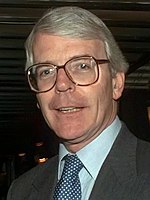First Major ministry
| First Major ministry | |
|---|---|
| 88th ministry of the United Kingdom (since 1707) | |
| 1990–1992 | |
 |
|
| Date formed | 28 November 1990 |
| Date dissolved | 9 April 1992 |
| People and organisations | |
| Head of government | John Major |
| Head of state | Queen Elizabeth II |
| Member party | Conservative Party |
| Status in legislature | Majority |
| Opposition cabinet | Kinnock Shadow Cabinet |
| Opposition party | Labour Party |
| Opposition leader | Neil Kinnock |
| History | |
| Election(s) | 1992 general election |
| Outgoing election | 1992 general election |
| Predecessor | Third Thatcher ministry |
| Successor | Second Major ministry |
John Major formed the First Major ministry after being invited by Queen Elizabeth II to begin a new government following the surprise resignation of the previous Prime Minister, Margaret Thatcher.
The resignation of Margaret Thatcher as Prime Minister came on 22 November 1990, more than 11 years after she had first been elected. She had won three consecutive general elections, been voted into power by more than 12,000,000 people, but had to step down because she couldn't count on the support of her own MPs. Former Cabinet Minister Michael Heseltine had challenged her leadership earlier in the November and although she fared better than him in the leadership contest, she was unable to gain an outright win and handed in her resignation, paving the way for a new Conservative leader more likely to win the next general election which was due within 18 months.
The announcement of the Community Charge (often referred to as the Poll Tax) during 1989 and the onset of a recession shortly before Thatcher's resignation had seen Tory support plunge in the opinion polls, most of which were showing a double-digit Labour lead and making it seem likely that Neil Kinnock would be the next Prime Minister.
Conservative MPs elected Chancellor of the Exchequer John Major as their new leader on 27 November 1990, and he was invited by the Queen to form a government the following day.
The change of leader from Margaret Thatcher to John Major saw a dramatic turnaround in Tory support, with the double-digit Labour lead in the opinion polls being replaced by a narrow Tory one by the turn of 1991. Although a general election did not have to be held until June 1992, Labour leader Neil Kinnock kept pressurising Major to hold an election during 1991, but Major resisted the calls and there was no general election that year.
...
Wikipedia
